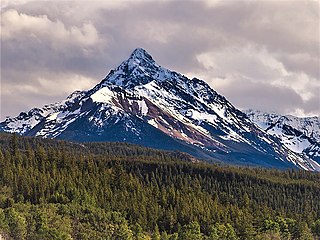
Otter Mountain is a prominent 2,693-metre (8,835-foot) glaciated summit located in the Coast Mountains of British Columbia, Canada. It is situated 16 kilometers northeast of Stewart, British Columbia, and the nearest higher peak is Mount Pattullo, 25.4 km (15.8 mi) to the north. Otter ranks as the 23rd most topographically prominent summit of Canada. Topographic relief is significant as the summit rises 2,380 meters above Bitter Creek Valley in 5 kilometers. This mountain's toponym was adopted as "Mount Otter" on 24 July 1945, and officially renamed Otter Mountain on 5 November 1953 by the Geographical Names Board of Canada. Precipitation runoff from the mountain drains west into Bitter Creek which is a tributary of the Bear River, or east to Nelson Creek which is part of the Nass River drainage basin, and all ultimately finds its way to the Inside Passage.

Mount Verendrye is a 3,086-metre (10,125-foot) mountain summit located in British Columbia, Canada.

Limestone Peak is a 2,878-metre (9,442-foot) mountain summit located in British Columbia, Canada.

Fairmont Mountain is a 2,628-metre (8,622-foot) summit located in British Columbia, Canada.

Taurus Mountain is a mountain summit located in British Columbia, Canada.

Mount Hanover is a mountain summit located in British Columbia, Canada.

North Albert Peak is a 2,934-metre (9,626-foot) mountain summit located in British Columbia, Canada.

Albert Peak is a 3,045-metre (9,990-foot) mountain summit located in British Columbia, Canada.

Mount Alcantara is a 3,029-metre (9,938-foot) mountain summit located in British Columbia, Canada.

Barbette Mountain is 3,072-metre (10,079-foot) summit located on the shared border of Alberta and British Columbia, Canada.

Mount Ogden is a mountain in the Canadian Rockies of British Columbia, Canada.

Overlander Mountain is a summit in British Columbia, Canada.

Klapperhorn Mountain is a summit in British Columbia, Canada.

Mount McKirdy is a mountain summit in British Columbia, Canada.

Whitesaddle Mountain is a summit located in British Columbia, Canada.

Blackhorn Mountain is a summit located in British Columbia, Canada.

Howser Peak is a 3,094-metre (10,151-foot) summit in The Bugaboos of British Columbia, Canada. It is located south of the Bugaboo Glacier and is the southernmost point of Bugaboo Provincial Park. Precipitation runoff from Howser Peak drains north into Bugaboo Creek which is a tributary of the Columbia River; as well as south to Duncan River via Howser Creek. Howser Peak is more notable for its steep rise above local terrain than for its absolute elevation as topographic relief is significant with the south aspect rising 1,380 meters (4,527 ft) in 2.5 km (1.6 mi).

Flattop Peak is a 3,063-metre (10,049-foot) summit in British Columbia, Canada.

Northpost Spire is a 2,911-metre (9,551-foot) peak in British Columbia, Canada.

Wallace Peak is a 2,940-metre (9,650-foot) summit in British Columbia, Canada.
























